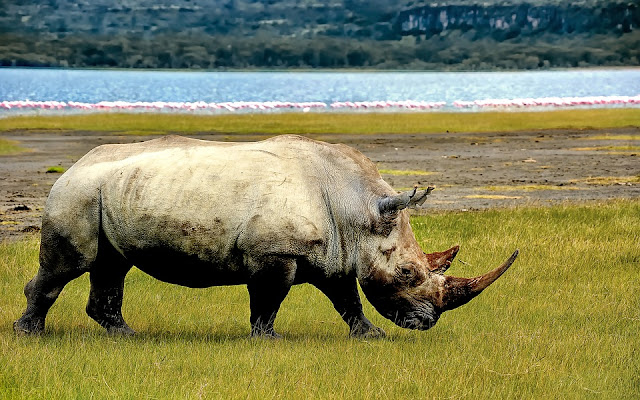Disclosure: Affiliate links to Amazon are included in this post.
Interesting Facts About Rhinoceroses
1. Rhinoceros get their name from the Greek word
rhinokerōs which means 'nose-horned.' This perfect name for
them because they can have one or two horns on their noses.
Their horns are made from keratin... the same material found in our
hair and fingernails!
2. The skin of the rhinoceros looks thick and leathery, but it's
actually quite sensitive. Rhinoceros can get sunburned if
they are in the sun for too long. This is why rhinoceros
enjoy rolling in the mud... it covers their skin and protects it
from the sun. It's also cool and soothing to them on a hot
day.
3. There are several types of rhinoceros that can be found
all over the world. They are the Greater One-Horned,
Black, White, Sumatran, and Javan. These rhinoceros live
in India, Nepal, Vietnam, Malaysia, and parts of southern
Africa. Their habitats vary. Some live in deserts,
grasslands, and savannahs. Others live in swamps and
rainforests.
4. Rhinoceros are herbivores and eat the vegetation found
in their habitats. They like to eat grass, leaves from
trees and bushes, and fresh fruits. Rhinoceros have huge
appetites and can eat up to 120 pounds of food a day.
5. Rhinoceros don't see very well. This is why you can
sometimes see them charging for no good reason. Even
though they have poor eyesight, rhinoceros have very strong
senses of hearing and smell.
6. A group of rhinoceros living together is called a crush.
7. Rhinoceros have very few predators. Sadly, humans
are their main predators. Hunters poach rhinoceros to get
their horns. They incorrectly think the horns have
medicinal properties and can cure them of a variety of
illnesses. Because of this, several species of rhinoceros
are critically endangered. That means they are 'in danger'
of becoming extinct!
8. The woolly rhinoceros went extinct about 10,000 years ago.
These rhinoceros had long, thick hair and a large hump behind
its shoulders. Scientists believe climate change and being
hunted by early humans caused them to go extinct.
How to Help the Rhinoceros
You may be wondering what you can do with your students to help the rhinoceros. There are a couple of things you can do. For example, you and your students can write letters to politicians and petition them to do more to protect the rhinoceros and their habitats. If the children are too young to write letters, then they can draw pictures to send.
Another idea is to 'adopt' a rhinoceros. Several organizations allow
you to symbolically adopt a rhinoceros and use the money you donate to
support their conservation efforts. What kind of fun fundraising
activities can you think of to help raise money for adopting a rhinoceros
for your school?
(Next Article:
10 Children's Books about Rosh Hashanah)











